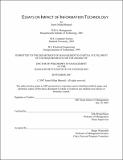| dc.contributor.advisor | Erik Brynjolfsson. | en_US |
| dc.contributor.author | Bhansali, Sumit Milap | en_US |
| dc.contributor.other | Sloan School of Management. | en_US |
| dc.date.accessioned | 2008-03-26T21:09:11Z | |
| dc.date.available | 2008-03-26T21:09:11Z | |
| dc.date.copyright | 2007 | en_US |
| dc.date.issued | 2007 | en_US |
| dc.identifier.uri | http://hdl.handle.net/1721.1/40861 | |
| dc.description | Thesis (Ph. D.)--Massachusetts Institute of Technology, Sloan School of Management, 2007. | en_US |
| dc.description | This electronic version was submitted by the student author. The certified thesis is available in the Institute Archives and Special Collections. | en_US |
| dc.description | Includes bibliographical references. | en_US |
| dc.description.abstract | The five essays in this dissertation look at how specific information technologies (such as Electronic Document Management (EDM), Semantic Web and RuleML) and IT in general can be used to automate and standardize data and processes, enable faster and more accurate information flow, and improve individual as well as firm performance. The first essay is an analytical review-type study in which we provide a comprehensive survey of research literature about different complementary organizational assets that when coupled with IT can lead to higher firm performance. In the second essay, we study the causal effects of digitizing work on information workers' time- use and performance at a large insurance firm. We make causal inferences and obtain unbiased estimates by exploiting a quasi-experiment: the phased introduction of Electronic Document Management (EDM) across multiple offices at different dates. In addition to large changes in time-use and performance, we find that digitization leads to a decline in the substitutable routine labor input and an increase in complementary non-routine cognitive labor input at the information worker level. We also uncover a new micro-level mechanism, "IT-enabled slack", that explains how exactly IT can lead to payoff in terms of information worker productivity. In the third essay, we examine the IT productivity relationship using a large primary source firm-level dataset about IT investments that spans the 2003-2005 period. Given results from previous studies, we present evidence of an inverted U-shaped returns curve, with returns now close to what they were in pre-Internet era. The fourth essay explores what high-performing firms specifically do to gain the greatest benefits from their IT investments. | en_US |
| dc.description.abstract | (cont.) Through a set of matched interviews with multiple respondents at 138 firms, we find that data/process standardization and systems integration, level of application integration and several IT-specific cultural elements are positively correlated with IT impact on customer satisfaction. The fifth essay shows the first detailed realistic e-business application scenario that exploits capabilities of the SweetRules V2.1 toolset for e-contracting using the SweetDeal approach. SweetRules is a powerful integrated set of tools for semantic web rules and ontologies. SweetDeal is a rule-based approach to representation of business contracts. | en_US |
| dc.description.statementofresponsibility | by Sumit Milap Bhansali. | en_US |
| dc.format.extent | 269 p. | en_US |
| dc.language.iso | eng | en_US |
| dc.publisher | Massachusetts Institute of Technology | en_US |
| dc.rights | M.I.T. theses are protected by
copyright. They may be viewed from this source for any purpose, but
reproduction or distribution in any format is prohibited without written
permission. See provided URL for inquiries about permission. | en_US |
| dc.rights.uri | http://dspace.mit.edu/handle/1721.1/7582 | en_US |
| dc.subject | Sloan School of Management. | en_US |
| dc.title | Essays on impact of information technology | en_US |
| dc.type | Thesis | en_US |
| dc.description.degree | Ph.D. | en_US |
| dc.contributor.department | Sloan School of Management | |
| dc.identifier.oclc | 212628678 | en_US |
